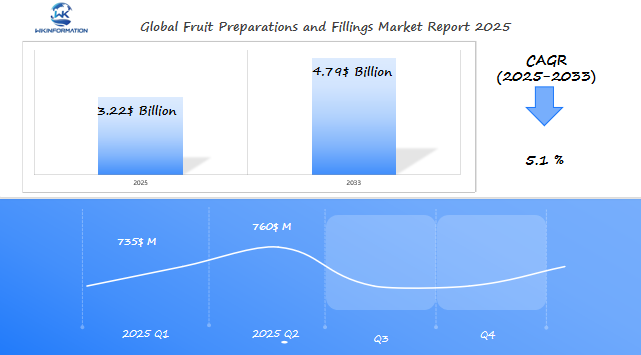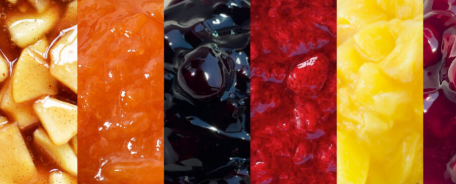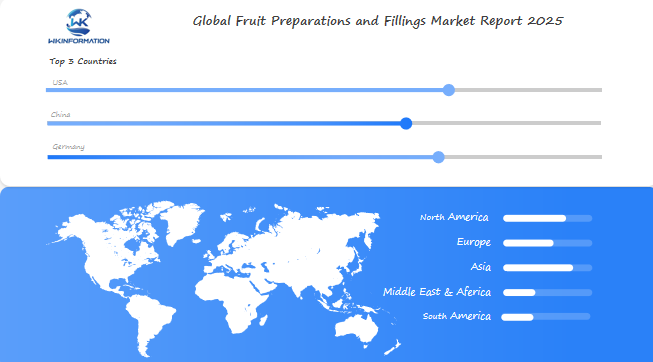2025 Fruit Preparations and Fillings Market Booming with $3.22 Billion Expansion in United States, China, and Germany
Discover how Trump’s trade policies reshaped the global Fruit Preparations and Fillings Market, with focus on key players USA, China, and Germany. Explore tariff impacts, market adaptations, and future trends in this comprehensive analysis of international trade dynamics in the food industry.
- Last Updated:
Market Forecast for Fruit Preparations and Fillings in Q1 and Q2 2025
The Fruit Preparations and Fillings market, estimated at USD 3.22 billion in 2025, is projected to grow at a CAGR of 4.4%. Based on market trends and seasonal demand patterns, the estimated market size for Q1 2025 is approximately USD 735 million, with a forecasted increase to USD 760 million in Q2 2025. The steady growth of this market is attributed to the rising consumer preference for natural, healthier food options, with increasing adoption of fruit-based fillings and preparations in bakery, confectionery, dairy, and foodservice applications.
The United States, China, and Germany are the primary regions for this market, benefiting from strong food processing industries and shifting consumer preferences towards clean-label, sustainable, and organic food ingredients. As consumer demand for healthier alternatives grows, manufacturers are responding by offering fruit preparations with fewer additives and preservatives, aligned with clean-label trends. Additionally, innovations in fruit processing techniques, such as freeze-drying and cold-pressing, are expected to enhance product quality and shelf life. Stakeholders in these regions should focus on product innovation and sustainability to meet evolving consumer needs while ensuring compliance with local and international food safety regulations.

Fruit Preparations and Fillings Market Upstream and Downstream Industry Chain Analysis
Understanding the industry chain analysis of fruit preparations and fillings involves a detailed look at both upstream suppliers and downstream consumers.
Upstream Suppliers
- Fruit Growers and Processors: These are critical players who provide the essential raw materials. The quality and availability of fruits directly impact the production of fruit preparations, making their role indispensable.
- Raw Material Sourcing: Seasonal variations and climatic conditions can affect fruit yields, influencing supply stability.
Downstream Consumers
- Bakery and Dairy Industries: These sectors are pivotal in driving demand for fruit preparations. Prepared fruits are widely used in cakes, pastries, yogurts, and more, highlighting their significance in these industries.
- Market Demand: As consumer preferences shift towards ready-to-eat products, the demand from these sectors continues to grow.
Supply Chain Dynamics
- Impact on Market Growth: Factors such as raw material availability and transportation costs play a significant role. Efficient logistics systems ensure timely delivery, affecting market competitiveness.
- Transportation Costs: Fluctuations in fuel prices or logistical challenges can impact overall product pricing, influencing consumer purchasing decisions.
This intricate network between suppliers and consumers underscores the complexity of the market dynamics in fruit preparations and fillings.
Key Trends Transforming the Fruit Preparations and Fillings Market in 2025
The fruit preparations and fillings market is undergoing a significant change, with several important trends reshaping its future.
1. Flavor Exploration
Consumers are increasingly interested in trying out different flavors, which is motivating manufacturers to come up with innovative products that feature unique and exotic flavors. This trend is driven by a global desire for new taste experiences, pushing companies to experiment with combinations like mango-chili or lavender-infused berries. Such creativity not only caters to adventurous consumers but also helps brands stand out in a competitive market.
2. Health Consciousness
There is a noticeable shift towards health-conscious products as consumers place greater importance on their well-being. This movement highlights the significance of using natural ingredients in product formulations. In response to the demand for healthier options, producers are focusing on reducing sugar content and eliminating artificial additives, aligning with broader wellness trends.
3. Clean Label Influence
Clean labels have become a crucial factor influencing purchasing decisions. Consumers are drawn to transparency, preferring products that clearly communicate their natural and simple ingredients. Brands that are responding to this trend often emphasize ‘no artificial preservatives’ or ‘100% organic’ on their packaging, enhancing trust and appealing to informed buyers seeking authenticity.
This evolving landscape highlights the need for industry players to embrace these trends, driving innovation and seizing new opportunities within the fruit preparations and fillings market.
Market Challenges and Barriers Impacting the Growth of Fruit Preparations and Fillings
The Fruit Preparations and Fillings Market faces several significant challenges that could impact its growth trajectory. A primary concern is the fluctuating cost of raw materials. Fruit prices can vary due to seasonal changes, adverse weather conditions, and geopolitical factors affecting supply chains. These fluctuations can disrupt production schedules and financial forecasting for manufacturers.
Another challenge lies in stringent food safety regulations. Compliance with these regulations demands ongoing investment in quality control systems and processes, which can strain resources, especially for smaller companies. Adherence to international standards is crucial for maintaining brand reputation and securing market share.
New entrants encounter substantial barriers to entry. The industry requires specialized equipment essential for processing fruit preparations to meet quality and safety standards. This equipment often represents a significant capital investment, deterring potential newcomers. Additionally, expertise in formulation development is imperative to create appealing products that meet consumer expectations for taste and texture.
Understanding these challenges is crucial for stakeholders aiming to navigate the complexities of this dynamic market landscape. Recognizing these issues enables businesses to strategize effectively, ensuring resilience against market volatility while maintaining compliance with regulatory demands.

Geopolitical Factors Shaping the Fruit Preparations and Fillings Industry Outlook
Geopolitical influences significantly impact the fruit preparations and fillings market, particularly through trade policies affecting key regions like the US, China, and Germany. These regions experience varying impacts due to their unique political landscapes and trade relationships.
1. United States
Trade policies in the US can alter import tariffs on raw materials essential for fruit preparations. Recent shifts in trade agreements with major partners may influence both costs and availability of these resources.
2. China
Political tensions between China and other global powers could lead to fluctuating tariffs on exported fruit products. Such changes may affect China’s role as a major supplier or consumer in this market segment.
3. Germany
As part of the European Union, Germany’s market is influenced by EU-wide trade regulations. Political developments within the EU or with external trading partners can create ripple effects in the availability and pricing of fruit-based ingredients.
Potential risks, such as tariff fluctuations or political tensions, pose challenges to market stability. Companies must navigate these geopolitical dynamics carefully to maintain supply chains and capitalize on growth opportunities in these pivotal markets.
Fruit Preparations and Fillings Market Segmentation by Type and Production Methods
The Fruit Preparations and Fillings market can be segmented by type into fruit fillings, fruit pastes, fruit jams, fruit purees, and fruit toppings. These products are further categorized based on production methods, which include conventional cooking, cold processing, and freeze-drying. Conventional cooking is the most widely used method, particularly for fruit fillings and jams, as it enhances flavor and texture. Cold processing, on the other hand, preserves the natural color and nutritional properties of fruits, making it a preferred method for producing high-quality purees and toppings. The growing demand for natural, organic, and preservative-free fruit-based ingredients is also encouraging the development of new production techniques to meet market needs.
Diverse Applications of Fruit Preparations and Fillings Driving Market Demand
Fruit preparations and fillings are increasingly being incorporated into a wide range of food products, fueling market demand. Key applications include bakery items such as pastries, pies, and cakes; dairy products like yogurts and ice creams; confectioneries; and ready-to-eat desserts. As consumer preferences shift towards healthier and more natural food options, fruit preparations are being used as replacements for artificial ingredients and sweeteners. Additionally, the rise in the popularity of vegan and gluten-free products has created new opportunities for fruit-based fillings, particularly in bakery and confectionery products. The versatility of fruit preparations in both sweet and savory applications further broadens their market potential.
Global Fruit Preparations and Fillings Market Regional Performance and Forecast
The global fruit preparations and fillings market is experiencing robust growth across all regions. In Europe, demand is driven by the presence of key manufacturers and an increasing preference for high-quality, natural fruit ingredients in food products. North America also represents a significant market, supported by rising consumer demand for premium, organic, and clean-label products in the food industry. The Asia-Pacific region is emerging as a high-growth market, with increasing urbanization and the growing middle class fueling demand for processed and ready-to-eat foods. Market growth in Latin America and Middle East & Africa is expected to remain steady due to expanding food processing industries and rising consumer interest in healthier food alternatives.

USA Fruit Preparations and Fillings Market Growth and Industry Strategies
In the USA, the fruit preparations and fillings market is benefiting from the rise in consumer demand for clean-label products, natural ingredients, and healthier alternatives in food manufacturing. Key strategies in the market include a shift towards organic, non-GMO fruit-based fillings and the use of natural sweeteners. Companies are also focusing on developing innovative products, such as sugar-free fruit fillings and allergen-free options, to cater to health-conscious consumers. Leading market players in the USA are focusing on expanding their product portfolios through mergers and acquisitions, as well as increasing their presence in the online retail space to reach a broader consumer base. Furthermore, partnerships with fast-growing bakery and ice cream companies have opened up new opportunities for growth.
Germany Fruit Preparations and Fillings Market Expansion and Competitive Analysis
Germany represents one of the largest markets for fruit preparations and fillings in Europe, driven by the country’s strong food processing industry. As consumer interest in premium and organic fruit ingredients rises, demand for high-quality fillings and preparations is growing in both the bakery and dairy sectors. Key players are investing in innovative production techniques such as cold processing to meet the growing demand for clean-label products. Competitive analysis reveals that companies in Germany are focusing on product differentiation through the development of specialized fruit fillings for specific consumer segments, such as sugar-free and vegan options. The market is also influenced by growing demand for convenience foods and ready-to-eat meals, which utilize fruit preparations for enhanced flavor.
China Fruit Preparations and Fillings Market Trends and Market Potential
China’s fruit preparations and fillings market is experiencing rapid expansion due to rising consumer demand for processed foods and beverages. The growing middle class, increasing urbanization, and a shift in consumer preferences towards healthier, more convenient food products are driving this demand. In particular, the use of fruit fillings in bakery products and the growing popularity of fruit-based desserts are key drivers of market growth. Additionally, the increasing acceptance of fruit-based fillings in savory foods and beverages, such as smoothies and juices, presents new opportunities. The Chinese market is also seeing growing interest in organic fruit fillings and health-conscious formulations, such as low-sugar and preservative-free options. As domestic production capabilities improve and export opportunities increase, China’s market potential is vast, positioning it as a major growth region in the global fruit preparations and fillings sector.
Future Innovations and Advancements in Fruit Preparations and Fillings Market
Technological advancements are reshaping the fruit preparations industry, driving production efficiency and aligning with consumer demands. Key innovations in food technology are enhancing various stages of production, from sourcing to processing, ensuring high-quality outputs that meet market standards.
1. Automation and Robotics
Many manufacturers are adopting automated systems to streamline operations. These technologies reduce manual labor, minimize errors, and increase throughput, particularly in sorting, peeling, and packaging processes.
2. Innovative Preservation Techniques
Techniques such as high-pressure processing (HPP) and freeze-drying help maintain the nutritional value and taste of fruits without relying on artificial preservatives. These methods cater to health-conscious consumers seeking clean label products.
3. Advanced Flavor Engineering
Companies are investing in flavor engineering to create new and unique taste profiles. This aligns with the growing trend of flavor exploration, offering consumers an array of choices that blend traditional tastes with exotic flavors.
Potential future innovations could include the development of eco-friendly packaging solutions that align with sustainability goals. As consumer preferences evolve, the integration of digital technologies such as IoT for real-time monitoring of supply chains is also anticipated to enhance transparency and efficiency.
These advancements not only boost productivity but also position companies to better respond to shifting market trends and consumer preferences.
Competitive Landscape and Leading Players in the Fruit Preparations and Fillings Industry
-
Puratos Group – Belgium
-
Dawn Food Products Inc. – United States
-
Agrana Beteiligungs-AG – Austria
-
CSM Ingredients – Netherlands
-
Bakels Worldwide – Switzerland
-
Barry Callebaut – Switzerland
-
Andros Group – France
-
Zentis GmbH & Co. KG – Germany
-
Rice & Company Inc. – United States
-
Fruit Filling Inc. – United States
Overall
| Report Metric | Details |
|---|---|
| Report Name | Global Fruit Preparations and Fillings Market Report |
| Base Year | 2024 |
| Segment by Type | · Fruit Pieces
· Fruit Purees · Fruit Juices · Jams and Preserves |
| Segment by Application | · Dairy Products
· Baked Goods · Ice Cream · Others |
| Geographies Covered | · North America (United States, Canada)
· Europe (Germany, France, UK, Italy, Russia) · Asia-Pacific (China, Japan, South Korea, Taiwan) · Southeast Asia (India) · Latin America (Mexico, Brazil) |
| Forecast units | USD million in value |
| Report coverage | Revenue and volume forecast, company share, competitive landscape, growth factors and trends |
The analysis of Trump’s trade and food policies reveals significant shifts in the fruit preparations and fillings market, with the U.S., China, and Germany taking center stage. Each country has navigated these changes uniquely, with impacts on production costs, supply chains, and international competition. Stakeholders must consider these findings to make informed decisions and adapt to evolving market dynamics.
- Future Developments: The post-Trump era promises new challenges and opportunities for the fruit preparations sector. Emerging trends may redefine market strategies and consumer preferences, requiring stakeholders to remain agile.
To gain a comprehensive understanding of these developments, it is crucial to explore deeper insights provided in the complete Wkinformation Research report. Your engagement with this resource will enhance your strategic positioning amid these global changes.
Global Fruit Preparations and Fillings Market Report (Can Read by Free sample) – Table of Contents
Chapter 1: Fruit Preparations and Fillings Market Analysis Overview
- Competitive Forces Analysis (Porter’s Five Forces)
- Strategic Growth Assessment (Ansoff Matrix)
- Industry Value Chain Insights
- Regional Trends and Key Market Drivers
- Fruit Preparations and Fillings Market Segmentation Overview
Chapter 2: Competitive Landscape
- Global Fruit Preparations and Fillings players and Regional Insights
- Key Players and Market Share Analysis
- Sales Trends of Leading Companies
- Year-on-Year Performance Insights
- Competitive Strategies and Market Positioning
- Key Differentiators and Strategic Moves
Chapter 3: Fruit Preparations and Fillings Market Segmentation Analysis
- Key Data and Visual Insights
- Trends, Growth Rates, and Drivers
- Segment Dynamics and Insights
- Detailed Market Analysis by Segment
Chapter 4: Regional Market Performance
- Consumer Trends by Region
- Historical Data and Growth Forecasts
- Regional Growth Factors
- Economic, Demographic, and Technological Impacts
- Challenges and Opportunities in Key Regions
- Regional Trends and Market Shifts
- Key Cities and High-Demand Areas
Chapter 5: Fruit Preparations and Fillings Emerging and Untapped Markets
- Growth Potential in Secondary Regions
- Trends, Challenges, and Opportunities
Chapter 6: Product and Application Segmentation
- Product Types and Innovation Trends
- Application-Based Market Insights
Chapter 7: Fruit Preparations and Fillings Consumer Insights
- Demographics and Buying Behaviors
- Target Audience Profiles
Chapter 8: Key Findings and Recommendations
- Summary of Fruit Preparations and Fillings Market Insights
- Actionable Recommendations for Stakeholders

Access the study in MULTIPLEFORMATS
Didn’t find what you’re looking for?
TALK TO OUR ANALYST TEAM
Need something within your budget?
NO WORRIES! WE GOT YOU COVERED!
Call us on: +1-866-739-3133
Email: infor@wkinformation.com
What are the key elements of Trump’s trade and food policies affecting the fruit preparations market?
Trump’s trade and food policies, particularly the ‘America First’ approach, have focused on imposing tariffs and reshaping international trade relations. These actions significantly impacted the global fruit preparations and fillings market, with the U.S., China, and Germany emerging as leading players.
How have tariffs influenced production costs in the fruit preparations market?
Tariffs imposed on imports have led to increased production costs in the fruit preparations market. This has resulted in shifts in pricing strategies and supply chain disruptions, including challenges in sourcing materials and transportation delays.
What is the current position of U.S. producers in the fruit preparations market after Trump’s policies?
In a post-Trump era, U.S. producers are adapting to new competitive dynamics by diversifying their strategies and exploring alternative export markets. Despite facing challenges from tariffs, they aim to maintain a strong position within the global fruit preparations sector.
How has China responded to U.S. tariffs on fruit preparations?
Chinese producers have adapted to U.S. tariffs through strategic adjustments in their export practices. They are navigating competitive dynamics while leveraging their strengths as exporters, though they face challenges due to retaliatory measures.
What strategies has Germany employed to remain competitive amid U.S. trade policies?
Germany’s food processing industry has focused on balancing compliance with EU regulations while competing globally. The country has developed strategies that allow it to adapt to U.S. trade policies while maintaining its market presence.
What are the future trends predicted for the global fruit preparations market post-Trump administration?
The future outlook for the global fruit preparations market includes potential long-term effects from Trump’s trade policies, evolving consumer preferences, and technological advancements. Experts predict that these factors will shape market trends and influence international trade dynamics.


